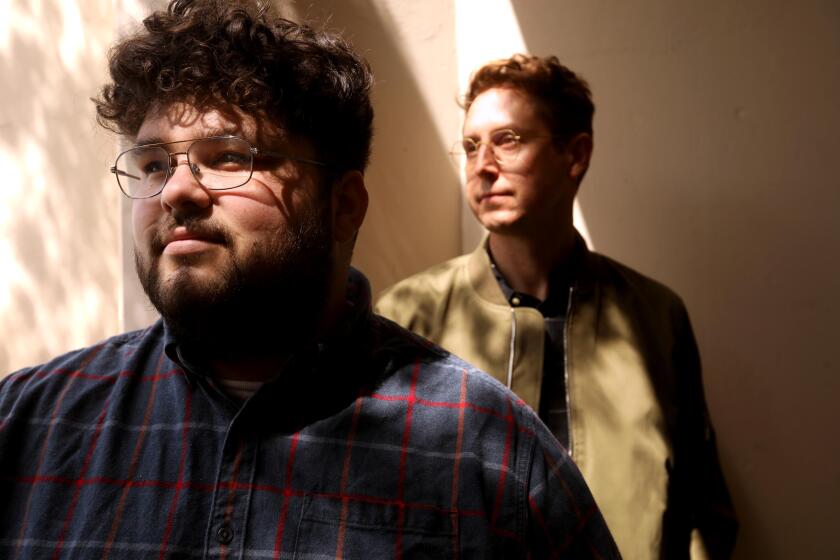L.A. Leads the Nation in Survey of Worst Traffic
Six California urban centers rank among the nation’s 20 most traffic-choked regions, with the Los Angeles-Orange County area once again topping the list, according to a new study from the Texas Transportation Institute.
The survey showed that San Francisco-Oakland jumped over the Seattle-Everett area of Washington to claim the dubious distinction of having the second-worst traffic delays in the nation in 1999, the last year studied.
San Diego ranked fifth, moving ahead of Miami, Boston and Atlanta between 1997 and 1999. It also recorded the single biggest jump in congestion among the nation’s cities since the study began in 1982.
All that congestion means that residents in the Los Angeles-Orange County region, which includes parts of Ventura County, spent the equivalent of nearly a week and a half of their lives per year sitting in traffic.
Counting hours spent idling in traffic and the cost of extra gasoline, Los Angeles-area residents spent about $1,000 more over the course of the year than they would have had traffic been moving freely over the same highways, the researchers said.
The estimated annual costs of congestion were: San Francisco-Oakland, $760; San Jose, $750; San Bernardino-Riverside, $685; San Diego, $675; and Sacramento, $605.
If it comes as any comfort to congestion-plagued Californians, the study shows that traffic snarls in other parts of the country grew much faster between 1992 and 1999. Of course, California is so far ahead that the rest of the country has a way to go before catching up.
The Texas Transportation Institute, affiliated with Texas A&M; University, is widely respected for producing an objective measure of the costs and delays associated with traffic. The study was financed by a number of state transportation agencies, including Caltrans.
Dennis Trujillo, a Caltrans spokesman, said the state is already moving to relieve some of the problem with the $5.3-billion congestion relief package added to the state budget last year by Gov. Gray Davis.
“We have our work cut out for us,” Trujillo said. He said the package of bus, rail and highway projects “was based on the governor’s recognition that we had to come up with a plan to mitigate congestion.”
San Diego also is making a bigger investment in transportation projects, as well as looking into land use issues in an effort to get a handle on the area’s congestion-related problems, said Garry Bonelli, a spokesman for the San Diego Assn. of Governments.
He said the jump in congestion was probably a result of the booming economy in San Diego. “We have a lot of people commuting to work,” Bonelli said.
Bonelli said congestion along the Interstate 15 corridor in San Diego County also was caused by people willing to drive farther to find affordable housing.
San Diego government leaders are trying to figure out ways “to put people where jobs are or put jobs where people are,” he said.
The study provided ammunition for supporters of mass transit and highway construction.
The Surface Transportation Policy Project, an organization that promotes public transit, released a companion study that included what it called a “Congestion Burden Ranking.”
That ranking used the Texas group’s numbers but factored in the use of public transit by workers in each city.
“The misery inflicted by traffic congestion is not the same everywhere,” said Roy Kienitz, executive director of the Surface Transportation Policy Project. “The places where commuters suffer most are the ones with the fewest transportation choices.”
Los Angeles ranked at the top of that list too, with 12.6% of workers using an alternative means of transportation to get to work. San Bernardino-Riverside ranked fourth among the nation’s cities, with 6.9% of its workers using something other than a car to get to work.
San Francisco-Oakland dropped to 29th because 23.8% of its workers, about 500,000 commuters, use alternatives to the car.
Larry Fisher, executive director of Transportation California, which represents the highway construction industry, said congestion was hurting California business.
“Travel in California over the last decade increased 10 times faster than new lane capacity was added,” he said.
(BEGIN TEXT OF INFOBOX / INFOGRAPHIC)
Traffic Jam
Most congested areas in the country in 1999:
*
Rank/Area
1. Los Angeles-Orange-counties*
2. San Francisco-Oakland
3. Seattle-Everett, Wash.
4. Washington, D.C.
5. Chicago-Northwestern Ind.
6. San Diego
7. Boston
8. Portland, Ore.
9. Atlanta
9. Las Vegas
11. Denver
12. Houston
13. New York City-Northeastern N.J.
13. Miami-Hialeah, Fla.
15. Detroit
15. Minneapolis-St. Paul
15. San Jose
15. Sacramento
15. San Bernardino-Riverside
20. Phoenix
*
Average annual traffic time delay per person in 1999:
*
*--*
Rank/Area Hours 1. Los Angeles* 56 2. Seattle-Everett, Wash. 53 2. Atlanta 53 4. Houston 50 5. Washington, D.C. 46 5. Dallas 46 7. Denver 45 7. Austin, Texas 45 9. St. Louis 44 10. San Francisco-Oakland 42 10. San Jose 42 17. San Bernardino-Riverside 38 19. San Diego 37 23. Sacramento 34 51. Fresno 18 65. Bakersfield 6
*--*
*
NOTE: Areas that are tied are listed with the same number ranking.
* Includes parts of Ventura County
*
Source: Texas Transportation Institute
More to Read
Start your day right
Sign up for Essential California for news, features and recommendations from the L.A. Times and beyond in your inbox six days a week.
You may occasionally receive promotional content from the Los Angeles Times.






